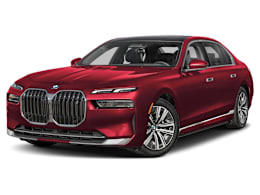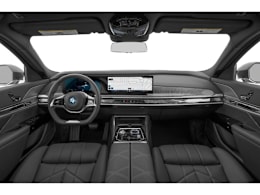Introduction
BMW i7 xDrive60
The German automaker launches a direct challenge to high-end electric sedans from Mercedes-Benz, Porsche, and TeslaOverview
BMW is charging into the ultra-luxury electric sedan market with its i7 series, which is introduced alongside the traditional, gasoline-powered 7 Series. The i7’s starting price is about $105,000 for the eDrive50.
The new i7 looks much like its traditional counterpart, but it’s underpinned by a large battery pack, and it’s driven by two electric motors—one in front and one in the rear—in place of the inline-six cylinder and V8 engines that have long been staples in BMW’s lineup.
With the new battery-electric version, BMW aims to compete in the ultra-luxury sedan segment dominated by Tesla, and now sees growing competition from Lucid Motors and luxury archrival Mercedes-Benz, which has already introduced an all-electric flagship EQS sedan and EQS SUV. The i7 competes with the Audi e-Tron GT, Lucid Air, Mercedes-Benz EQS, Porsche Taycan, and Tesla Model S.
BMW got into the EV game relatively early with its i3, an electric city car that has had limited success in the U.S. since becoming available at dealerships here for the 2014 model year. It was joined by the rather exotic i8 sports car. Since that first electric wave, the automaker has steadily introduced new production models, including the i4 and iX SUV. Plus it has announced plans to introduce electric versions of the 5 Series and 7 Series sedans, and the X1 SUV. In all, BMW says it will bring roughly a dozen new EVs to market by 2025. Mini and Rolls-Royce also fall under the BMW umbrella; a Mini Cooper electric model is already available and an electric Rolls-Royce Spectre is coming in 2023.
The new 7 Series is a big car and has grown more than 5 inches longer than the previous model, to 212.2 inches. It is also nearly 2 inches wider and 2 inches taller. For the most part, it looks like a generic sedan—conservatively styled and relatively nondescript. It bears passing resemblance to a Rolls-Royce, except for the front-and-center kidney/baboon posterior-shaped grilles, and the Hofmeister kink in the rear door window’s trailing edge. Those two cues are very BMW. The slit headlamps on either side of the grille are new but are what BMW says is part of its new design language.
Outside of the steering wheel, don’t expect to find many buttons. The interior aesthetic is spare in a refreshing way, and screens tend to dominate. The 12.3-inch instrument cluster and 14.9-inch infotainment screens are combined behind a single, curved glass strip that takes up a good bit of real estate on the upper dash. BMW says it has designed touch-screen operation to resemble smartphone function, including bold, easily recognizable icons that can be moved to a favorites bar depending upon the driver’s preference. There is a smartphone-sized control panel—glass-faced with app-like selections—in the armrest of each rear door.
A glass spear runs across the entire dash beneath the curved instrument panel. BMW is calling it the “interaction bar,” and most of it is a touch screen that operates the climate system controls, glove box door, and other functions. It can be configured in a variety of colors and themes, and can also display moving graphics. The heating and cooling vents are mere slits and don’t command much notice.
The center console contains a large storage cubby, and there is a smaller one in a fold-down armrest in the middle of the rear seatback. The armrest also conceals a pass-through door for longer objects, such as skis.























